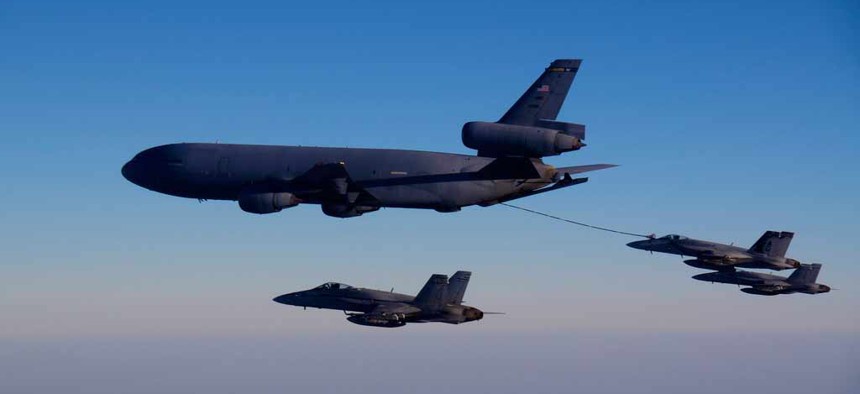
A KC-10A tanker refuels one of the Navy's F/A 18 fighter jets U.S. Navy photo by Mass Communication Specialist 3rd Class Kevin J. Steinberg
The Navy Just Turned Seawater Into Jet Fuel
Researchers announce a major breakthrough, but don’t go filling your F-18 with ocean water just yet. By Patrick Tucker
Announcing a major breakthrough, Navy researchers for the first time have converted seawater into CO2 and hydrogen, which could be used to produce jet fuel within a decade.
In the next seven to ten years, the military will be able to run jets, ships, and other vehicles on a fuel derived from seawater, according to Heather Willauer, a research chemist with the Naval Research Laboratory or NRL.
“It has to meet military specifications to go into a jet,” Willauer said, at the annual Sea Air Space Expo near Washington, D.C., on Tuesday. “We haven’t actually made it to the specifications stage yet. But we know we’re in the hydro-carbon region and it shouldn’t be very difficult to meet that specification.”
The breakthrough, though impressive, does not mean that we will be filling jets and ships with seawater in the very near future. The fixed-bed catalysis process Willauer and her team used to recover the hydrogen and the CO2 from the seawater is highly energy-intensive, requiring almost twice as much electricity to convert the water into fuel components as the process yields in terms of power. Catalysis is a process that combines chemicals, energy and pressure to accelerate chemical reactions. At current energy pricing, the cost of the fuel is between $3 to $7 per gallon. Willauer says the numbers should get better in the years ahead.
With a stable and, hopefully, clean electricity source, seawater-based fuel could reduce dependence on oil or other polluting fuel sources, first in the military and then elsewhere. “The idea is really from a logistics standpoint, you’re no longer dependent on foreign fossil fuel,” said Willauer. “You can make fuel where and when you need so you can stay on station, and it elevates that burden cost of fuel, of carrying it to different parts of the world.”
